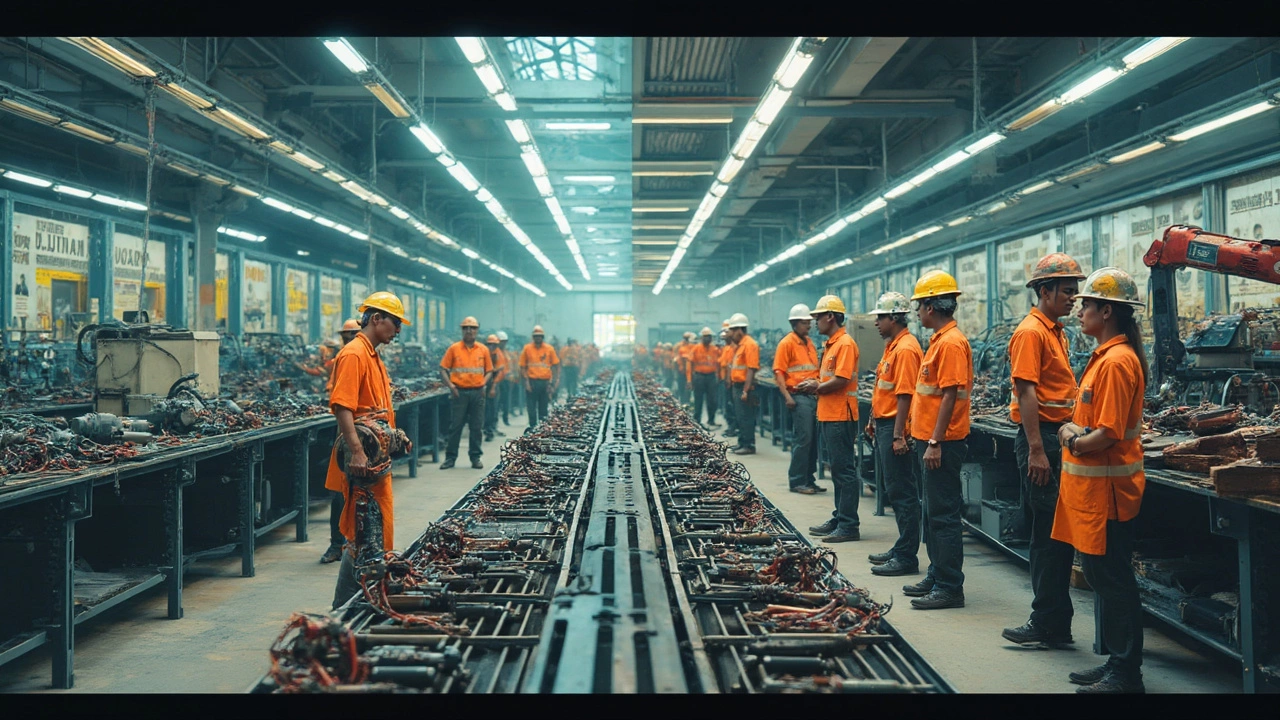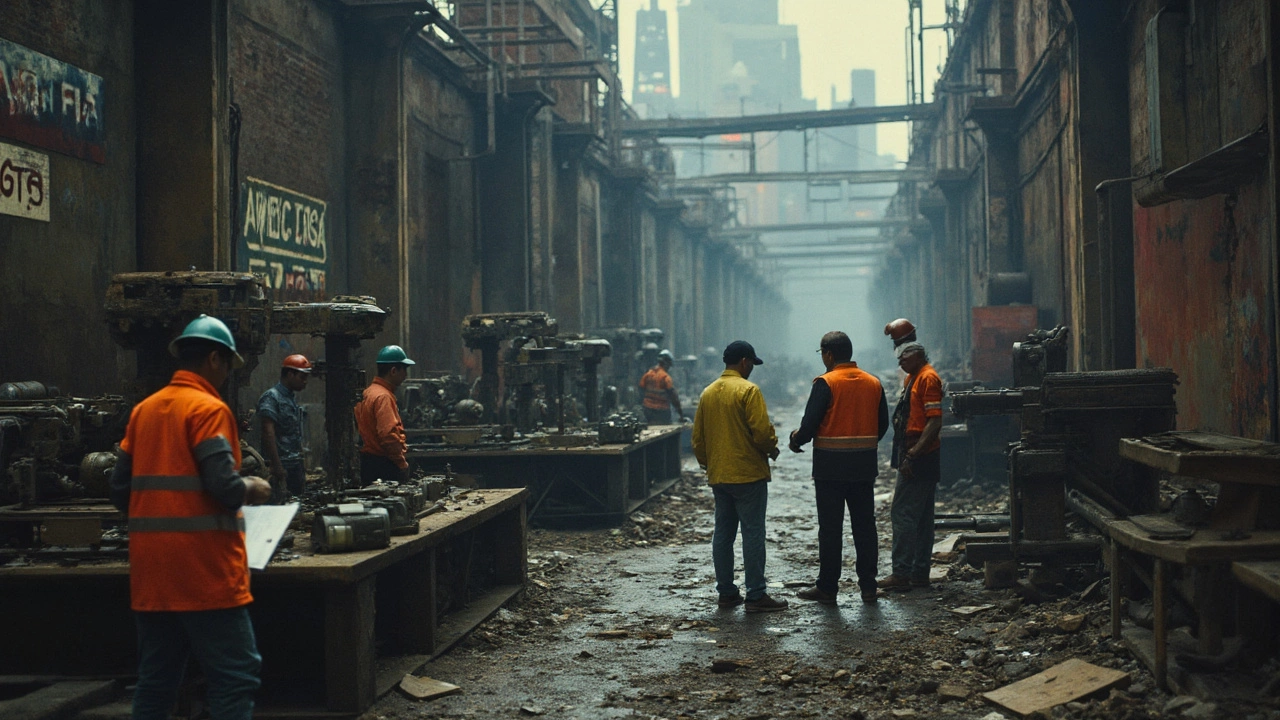America used to be the place where stuff got made. Think cars rolling off Detroit assembly lines, jeans stitched in North Carolina, steel forged in Pittsburgh. This wasn’t just ancient history—your parents probably remember seeing “Made in USA” on just about everything around the house.
Fast forward: Whole towns that once thrived on factory jobs are now struggling. One day, there were three shifts at the local plant. The next, the machines went quiet. It seemed like the country just let manufacturing slip away. But was it really a random accident, or did it happen by design?
Trade policy played a huge role. With NAFTA in the ’90s and then deals with China in the 2000s, the rules changed almost overnight. A real eye-opener: a study from MIT found that over 2 million jobs disappeared between 1999 and 2011, just from imports from China ramping up. It was a punch most towns never saw coming.
But there’s more to the story—automation, robots, and shifting government priorities also nudged factories out. Want to know why so much of your stuff now says “Made in China” or “Made in Mexico”? It wasn't just about cheaper labor; it was about government incentives, or sometimes, the lack of them.
- When American Manufacturing Boomed
- How Trade Deals Changed Everything
- Tech Disruption and Automation
- What Government Schemes Did (and Didn’t) Do
- Is There a Way Back for US Factories?
When American Manufacturing Boomed
Back in the day, you couldn’t talk about the American economy without mentioning its factories. After World War II, the U.S. became the world’s top producer of cars, TVs, appliances—you name it. This wasn’t just good for big cities; small towns thrived, too. People moved for reliable jobs, steady pay, and those rare unicorns—solid benefits and pensions.
The numbers were wild. In 1979, about 19.4 million Americans worked manufacturing jobs. That was more than 20% of the workforce. Now, it’s less than 8%, and we’ve dropped under 13 million. Factory work was the backbone of the middle class. It helped families buy homes, send kids to college, and even take a vacation now and then.
If you want facts, here’s one: America made one out of every four goods produced on the planet during the late ‘40s and ‘50s. No country came close. Check out this table for a quick look at manufacturing back then:
| Year | Manufacturing Jobs (millions) | Share of Global Output (%) |
|---|---|---|
| 1950 | 16.7 | 28 |
| 1979 | 19.4 | 25 |
| 2023 | 12.9 | 17 |
Factories meant more than paychecks. Local diners, hardware stores, and car dealerships thrived because people had money to spend. Even public schools were better funded. When factories were humming, whole communities felt secure.
America manufacturing was so dominant some people doubted it could ever fade. But all that started to shift once new policies and technologies rolled in, changing the game for good.
How Trade Deals Changed Everything
If you look at why America manufacturing faded, trade deals are front and center. These agreements weren’t just about making stuff cheaper for shoppers—they reshaped where companies chose to put their factories.
It started picking up steam with NAFTA (the North American Free Trade Agreement) in 1994. This deal made it a lot easier—and less costly—for U.S. companies to build factories in Mexico and ship goods back home. Overnight, stuff like auto parts and electronics started rolling off Mexican lines instead of American ones.
Fast forward to 2001, and the U.S. gave China permanent “Most Favored Nation” trading status. This is the point where things really shifted. American stores filled up with cheap imports. Study after study shows a huge spike in factory shutdowns and layoffs, especially in smaller towns that relied on manufacturing jobs.
Here’s a quick look at the numbers showing the impact of these trade deals:
| Trade Deal | Year | US Manufacturing Jobs Lost (est.) |
|---|---|---|
| NAFTA | 1994 | ~900,000 |
| China MFN/WTO Entry | 2001 | ~2.4 million |
Companies say they had no choice. Cheaper labor and fewer rules overseas meant if they didn’t move, they couldn’t compete. Washing machines, shoes, TVs—almost everything Americans used to make started coming in from abroad. Whole supply chains got uprooted, especially in the Midwest and South.
It wasn’t all accidental, either. There were special tax breaks for moving jobs out, and the government promised free retraining programs that didn’t always deliver. If you ever wondered why your favorite American-made brand vanished or the big local plant shuttered, these trade deals were a big piece of it.
Tip: If you want to spot the impact around you, notice what labels you see at the mall or electronics store. Odds are, things that once were made close to home now come from thousands of miles away. That shift started with policy—not just demand or technology.

Tech Disruption and Automation
Robots on the factory floor aren’t just a sci-fi thing; they’re a big reason lots of jobs vanished. Automation and new tech hit factories especially hard after the ’80s. In fact, a 2017 Ball State University report estimated that over 88% of the factory jobs lost since 2000 went because of automation, not because companies moved overseas.
Think about a simple car factory. What used to take dozens of workers—welding, painting, assembly—now takes a handful of people running machines. It’s way faster and cheaper for companies, but not great if you were counting on those jobs to stick around.
America manufacturing didn’t disappear just because of wages abroad. American firms invested big in automation to stay competitive. Here’s the kicker: between 1990 and 2018, manufacturing output actually went up by almost 40%, but the number of jobs dropped by around 25%. More stuff, fewer workers.
"Almost nine out of ten lost manufacturing jobs in America since 2000 are due to automation and productivity, not trade." — The Economist, 2017
Check out how productivity shot up while jobs went down:
| Year | Manufacturing Output Change | Manufacturing Jobs Change |
|---|---|---|
| 1990-2018 | +39% | -25% |
The big takeaway? Tech isn’t slowing down. Self-driving forklifts, robots that never take a day off, and AI systems track quality in real time. That all sounds cool—unless you’re trying to get hired at a factory. So, is automation all bad news? Not exactly. It created demand for new jobs—robot programmers, maintenance techs—but those usually need more training and pay more. If you want to stay ahead, learning skills that work with the machines, instead of competing against them, is key.
What Government Schemes Did (and Didn’t) Do
If you think the government just watched manufacturing leave America, that’s not the full story. There were loads of laws, grants, and incentives cooked up to help save or even revive factory jobs, but the results have been all over the place.
One big example is the America manufacturing supports that surfaced in the late 2000s. Remember the American Recovery and Reinvestment Act of 2009? Part of Obama’s massive stimulus dumped billions into green energy factories and construction. Some solar panel and battery plants did open, but way fewer jobs were created than promised. Specific areas, like Detroit, got a boost with bailout cash for car makers. Not every town got that lucky.
Trade adjustment programs tried to help laid-off factory workers retrain for new careers. On paper, this sounds awesome. In real life, less than half of people who took these retraining programs landed steady jobs. No surprise, folks wanted their old factory paychecks—not lower-paid office gigs or tech support.
Plenty of politicians talked a good game about “Buy American” acts. These rules were meant to make the government buy more US-made products. But there were so many loopholes, lots of stuff still came from overseas. Even the Department of Defense regularly buys parts from abroad when it’s cheaper.
On the flip side, some tax cuts and incentives actually nudged companies to outsource. Between 2000 and 2018, companies got tax breaks for profits earned in other countries, not at home. Why keep a plant in Ohio when you can pay less in taxes by moving it to Vietnam?
"We gave up whole industries, and then tried to get clever with rules to bring one or two factories back. But that’s like putting a band-aid on a broken leg," said Susan Houseman, an expert at the W.E. Upjohn Institute for Employment Research.
It all boils down to this: government schemes sometimes slowed the bleeding but rarely stopped the exodus. The plans usually ended up helping a few big industries, not the little guys, and hardly ever brought back those classic blue-collar jobs people actually wanted.

Is There a Way Back for US Factories?
So, can America actually bring back its manufacturing edge, or is that ship long gone? The truth: There’s a lot more buzz around reshoring now, and some companies are quietly reopening plants, especially for things like electronics, batteries, and medical supplies. This isn’t just talk—Apple has started making some iPhones in Texas, and Ford’s building electric vehicles in Michigan. It’s not on the scale it used to be, but it’s a sign.
The government’s started to wake up to the problem. The 2022 CHIPS Act is throwing billions at companies to build microchip factories here. Before this, the U.S. made only about 12% of the world’s chips—a huge drop from the ’90s when it was above 35%. Now, new factories are popping up in Arizona and Ohio. Politicians call this a national security thing, but it’s also about jobs and supply chain headaches revealed during the pandemic.
Here's a snapshot of recent government moves boosting American manufacturing:
- Offering tax credits and subsidies for green tech—batteries, solar panels, electric cars.
- Requiring federal projects to use more American-made materials.
- Pushing for workforce training to fill skilled jobs factories need.
Check out some numbers that show how things are changing:
| Year | Factory Openings | Manufacturing Jobs (millions) |
|---|---|---|
| 2010 | 470 | 11.5 |
| 2015 | 520 | 12.3 |
| 2022 | 740 | 13 |
It’s not all smooth sailing. American factories have to pay higher wages and deal with stricter rules, so competing with cheap imports is still tough. Robots and automation also mean new jobs don’t always look like the old ones—think programming and machine maintenance, not just working the assembly line.
If you’re eyeing a factory job or just care about products made in the USA, here’s what helps: Look for skills in robotics, quality control, or green energy. Programs at community colleges and trades schools now include everything from welding to operating high-tech equipment. Even companies are starting to train people straight out of high school for these roles.
Factories aren’t coming back overnight, but the momentum is real. The more people push for American-made—and the more the government invests—the more you’ll see local towns getting noisy again, not silent.
